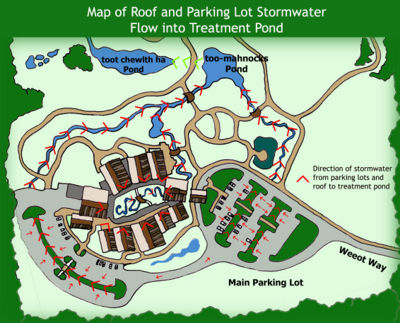Introduction
A main goal of Potawot is to be sustainable. This includes natural water treatment and responsible resource management. Potawot uses swales as a part of the treatment system to manage and treat runoff.
Specifically, Potawot uses bioswales, which include vegetation. Bioswales decrease the speed of water flow, provide a containment area for runoff, and encourage suspended solids to settle out of the water. The plants in a bioswale filter pollutants and contain and decompose them in the soil. [1]
The swales are one part of the larger natural water treatment system at Potawot. Runoff is filtered in the swales, and pollution is thus controlled. Once the water passes through the swales, it empties into the treatment pond.
The swales are one aspect of Potawot’s commitment to sustainable resource usage. Instead of allowing runoff to become a waste, Potawot has a method to utilize runoff to assist another of Potawot's main goals: to preserve the natural habitat. The swales create an ideal area for native plant growth. [2]
Locations

The swales are positioned at the Potawot grounds to collect excess runoff. Designed to use gravity to transport the water, they are connected to each other by culverts and form a system to channel runoff into the treatment pond.
The swales are located near Potawot’s parking lots, as shown in the diagram. They are placed there because non-soil surfaces such as concrete generate large amounts of runoff. Water is unable to penetrate these materials and sink into the ground during rains.[2]
Function/Treatment
As part of Potawot's treatment system, the swales are designed to maximize the natural treatment of the water. Like all bioswales, the swales have a fairly low grade, in order to slow the water as it travels. This encourages water to collect for extended periods of time, because the longer the water remains, the more sinks into the ground. Much of the water travels in the subsurface, or below the top layer of soil. This promotes the filtering of sediments and pollutants such as metals [3].
The water levels in the swales are shallow. They are 1-2 inches deep during an average rainfall and 5-6 inches deep at maximum capacity.
Native Vegetation
Native plants and shrubs are deliberately planted and encouraged to grow in the swales. These species are:
- Scirpus microcarpus - Small-fruited Bulrush
- Cornus sericea var. stolonifera - Red-twig Dogwood
- Juncus effuses - Juncus
- Deschampsia cespitosa - Tuft Hairgrass
- Alnus rubra – Red Alder
- Acer circinatum – Vine maple
- Salix – Willow
- Carex obnupta – Slough sedge
These plants serve multiple purposes. They assist the filtering process as well as help collect the water in the ground through their roots, including rhizomes. Importantly, they support the larger aim of Potawot to encourage native habitat renewal. [2]
Maintenance
The swales require a mild amount of upkeep to remain functional. This mainly consists of ensuring flow by manually unclogging the culverts. Also, nonnative and invasive plants are removed to allow the native plants to grow. [2]
References
Further Reading
Design Manual: Biological Filtration Canal (Bioswale)
Bioswales
<layout name="AT device" />